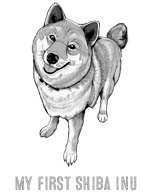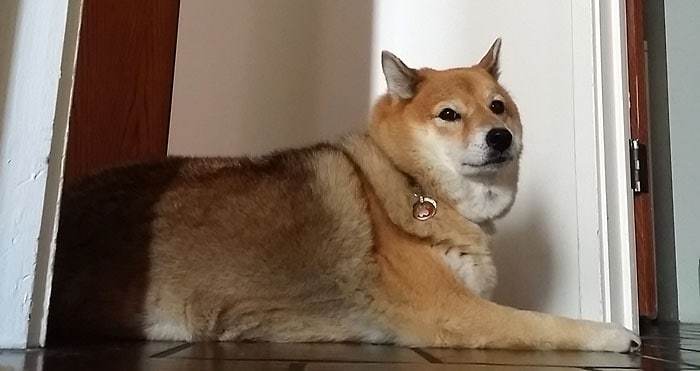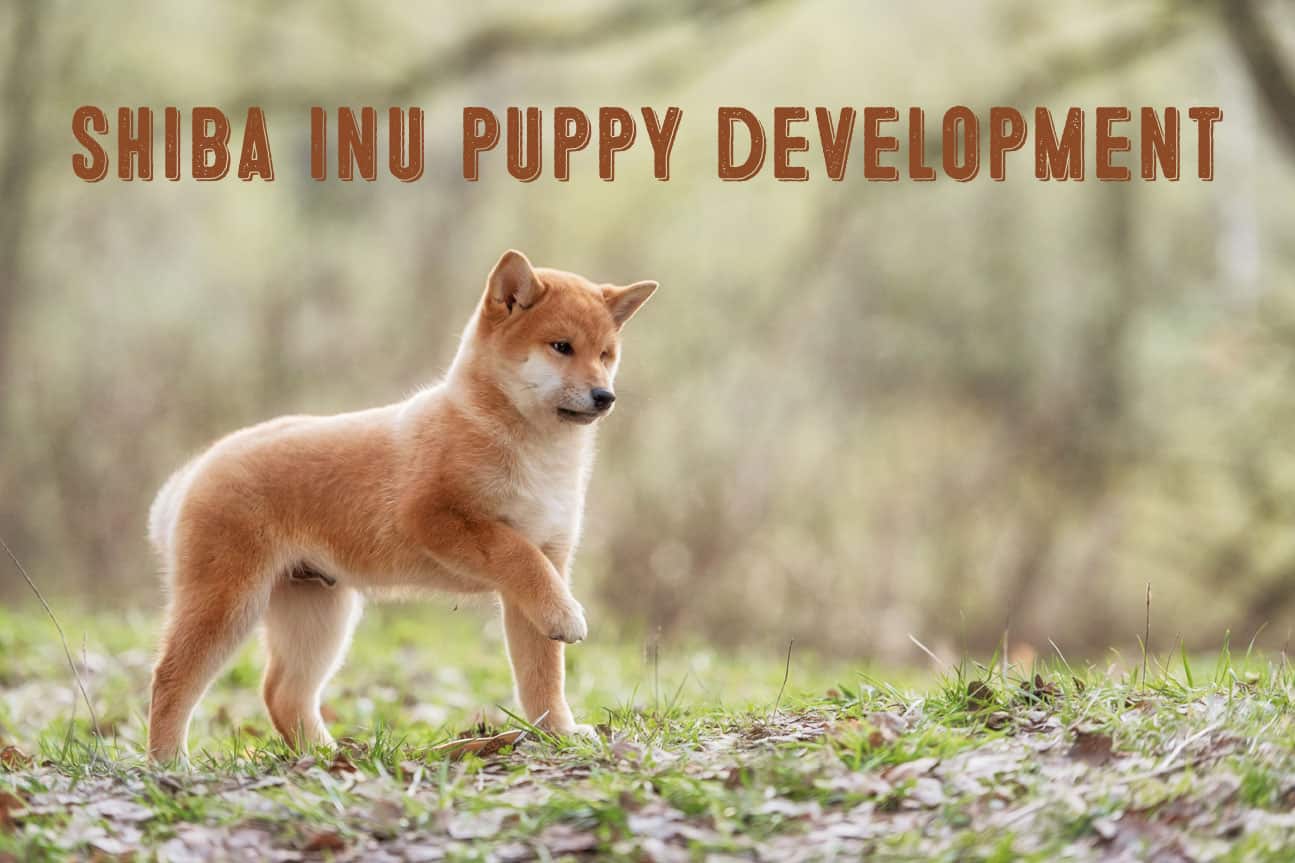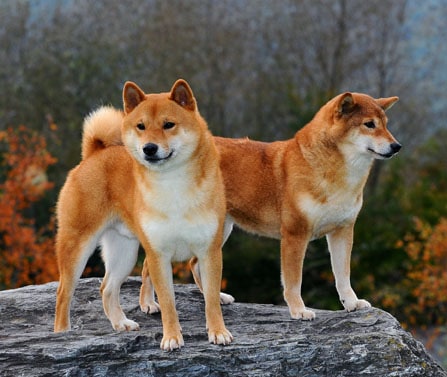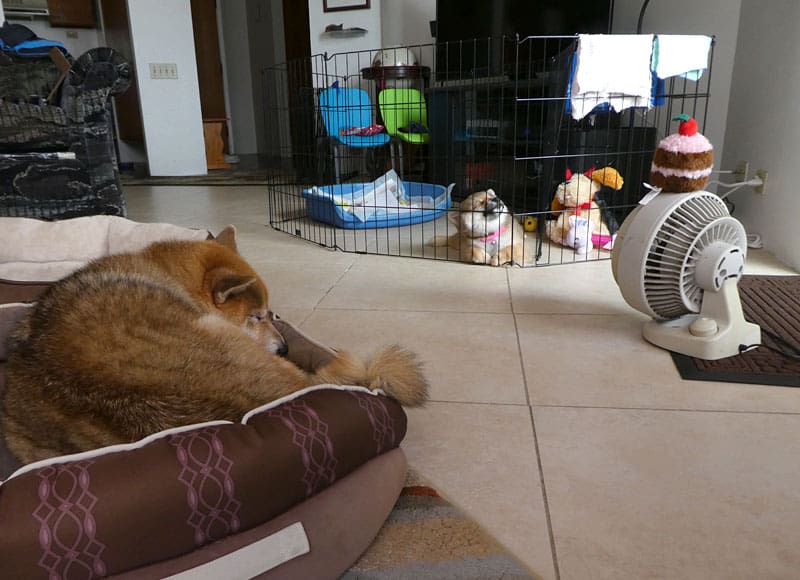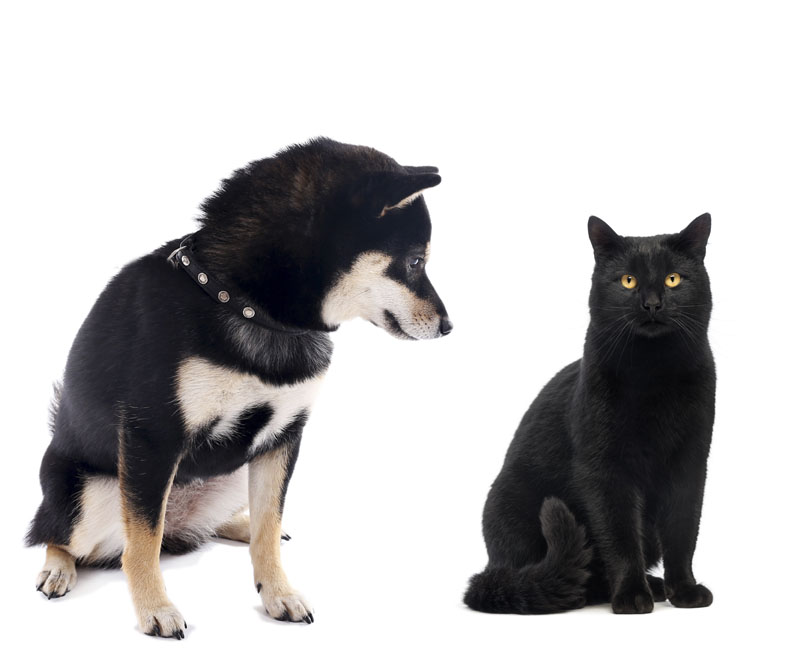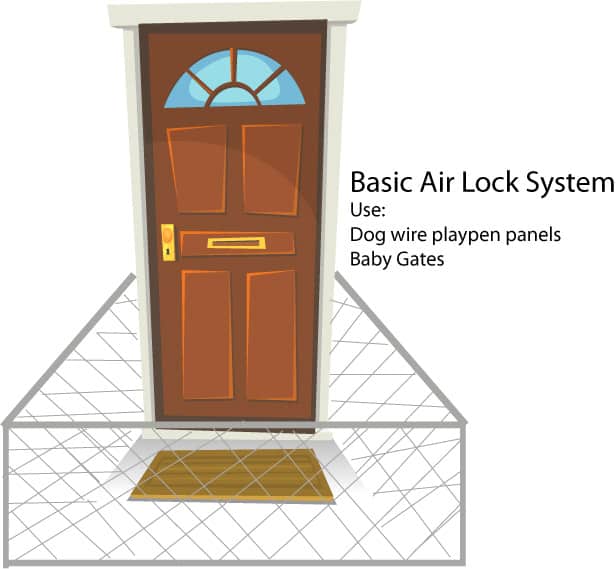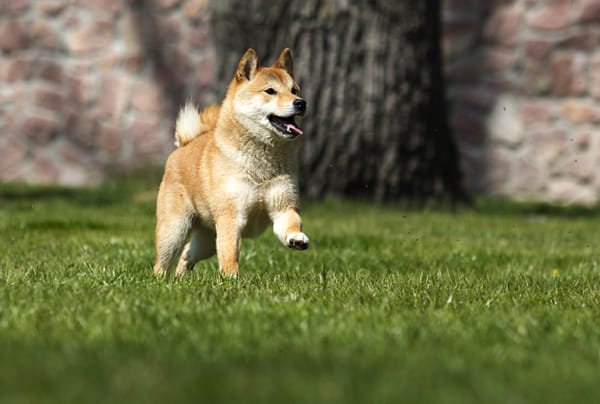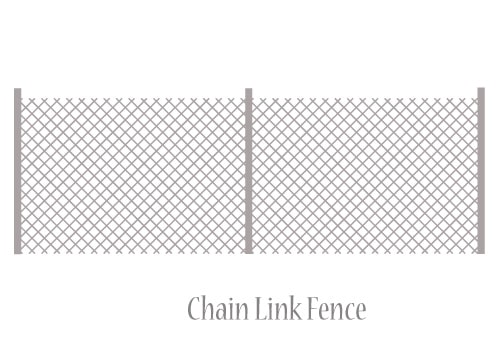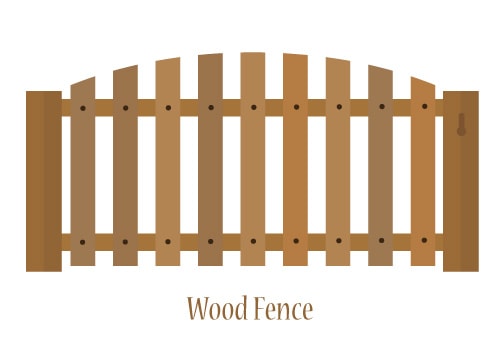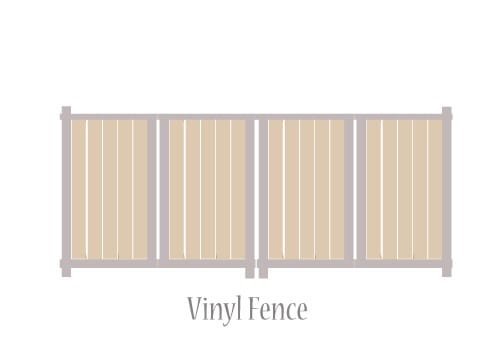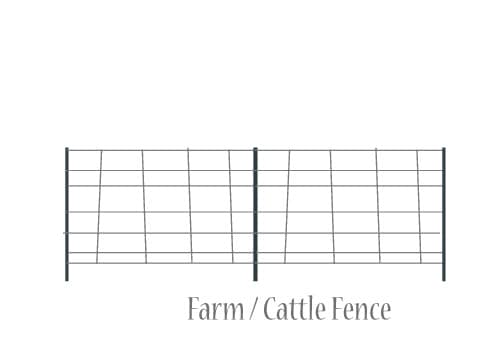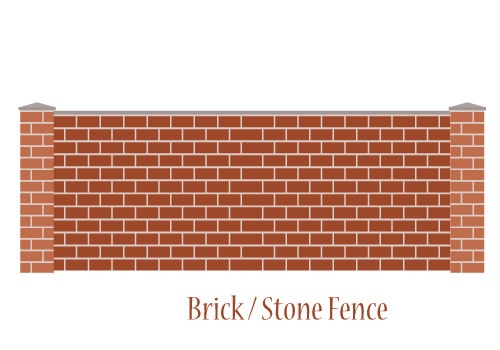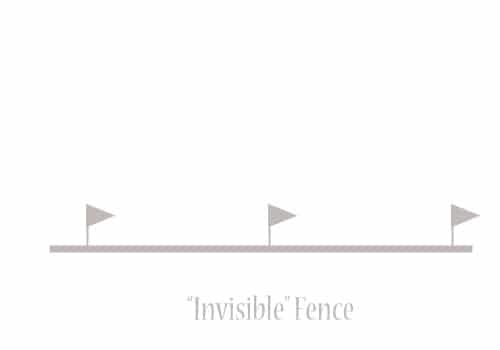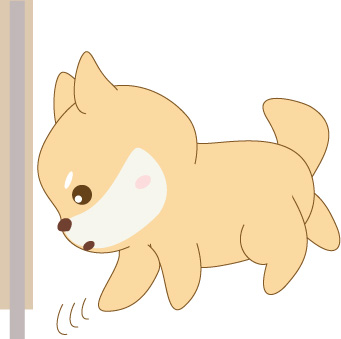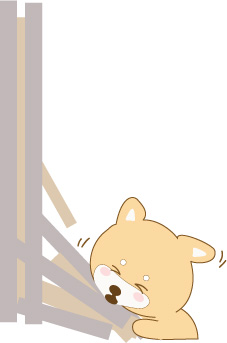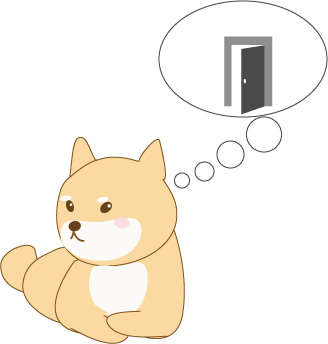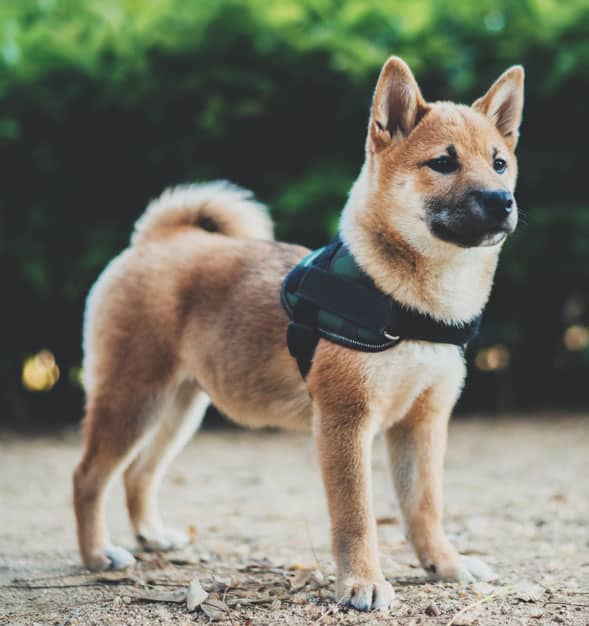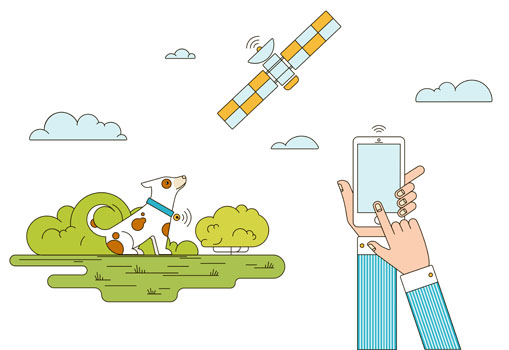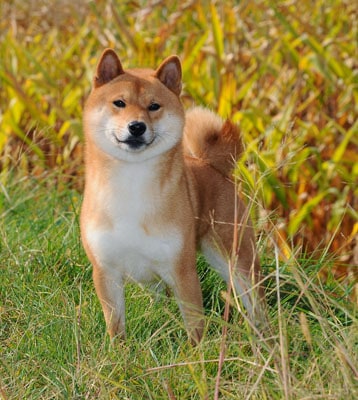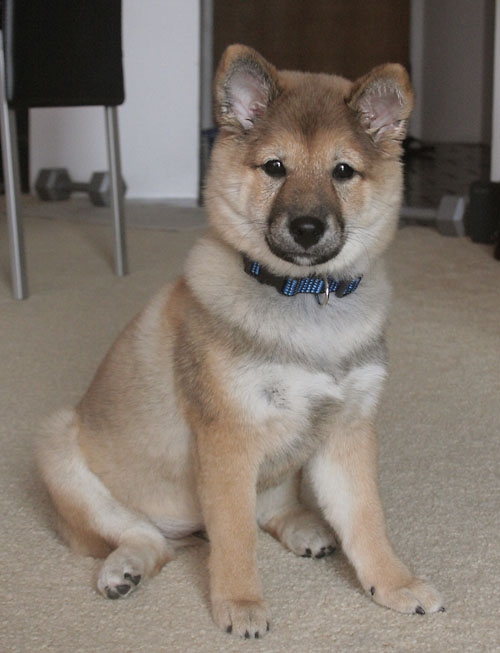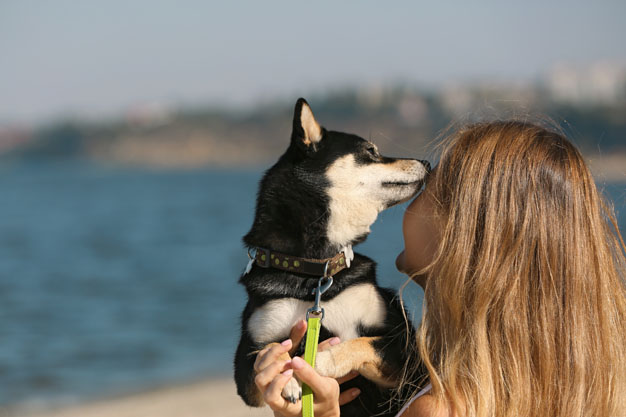On occasion, our posts contain affiliate links. However, we only recommend products that we truly believe in. For more information, visit my privacy policy page.
The term Shiba Inu “escape artist” may sound lighthearted and humorous on the surface – but in reality – it’s a serious issue.
Owning a Shiba Inu that constantly escapes will likely take a lot of continued intervention, training, and patience.
While roaming is a natural instinct in canines – escaping is a learned habit that unfortunately your Shiba will never forget.
Most escapes will lead to serious consequences such as runaways, injuries, and even death.
How many times have you heard of tragic stories of a Shiba Inu bolting from a door and getting fatally hit by a vehicle?
This shouldn’t happen.
There should never be just one door between safety and life-threatening harm – we can do much better to protect our beloved family members that don’t understand street safety.
While accidents sometimes do happen with no fault on anyone – a majority of these tragic incidents CAN be prevented simply by taking a few extra security measures.
Keep Your Escape Artist Shiba Inu SAFE – 8 Golden Rules
1
Find the root cause of escaping – work on remedying the issue
2
Provide an escape-proof living environment (no excuses)
3
Always use a double – barrier / airlock system at critical exit points
4
Crate train for peace of mind / safety
5
Have the right stuff! – Be equipped and ready
6
Microchip / I.D Tags / G.P.S. for serious cases
7
Obedience train with 100% compliance goal – 2 commands is a must
8
Bond with your Shiba Inu… tightly
1 – Getting To The Root Cause of The Issue
Ideally, finding the root cause of the escaping is far better than simply trying to continuously control the issue with reinforcements and constant monitoring.
So while security measures and monitoring is critical, do your best to make progress in identifying and remedying the root cause of the escaping.
Could it be an issue with bonding, training, anxiety, or simple boredom?
More often than not, a common cause of escaping is due to dog / owner bonding and basic obedience training.
Gaining the trust and respect from your Shiba Inu is the most important goal you must achieve as soon as possible.
This process is much, much, much easier if your are raising your Shiba from young puppyhood.
Training and socializing your Shiba during the critical puppy development period is by far the most crucial thing you can do to eliminate long term behavioral issues.
Unfortunately, many owners simply do not devote enough time to structured training and socializing during puppyhood.
Often times, the stress and extra work of caring for a young pup leaves little time and / or energy for training.
But it must be done.
The rewards and benefits of the time you put in goes up 100x fold in the future. Because most issues like:
- Aggression
- Fearfulness
- Aversion to grooming / baths
- Escaping
Are all due to……. You guessed it – inadequate socialization / training during puppyhood.
Other Reasons Dogs Escape
Looking For Mates –
Dogs that are not spayed or neutered are more likely to try to escape to find potential mates.
If you plan to keep your dogs intact, it’s important that you take extra measures to ensure their and other dog’s safety.
Loneliness –
Dogs are social / pack animals and should never be left alone for long periods of time. Owners of single dogs who are gone for most of the day should really consider getting another dog for companionship.
Lonely dogs can suffer from depression and anxiety just like humans with minimal interaction.
Uncomfortable Environment –
Just because dogs don’t understand modern home decoration, doesn’t mean they should tolerate shabby digs.
A dog’s living area should be a place that is clean, comfortable, and “happy”.
This means that your Shiba should have a comfortable bed, tons of toys and games, ample water, and be located in an area that is not isolated.
If you leave your dog in an isolated area that is uncomfortable and depressing, it’s no wonder why your dog would want to escape.
Predatory Instinct
Some dogs (like Shiba Inus) possess high prey drive and wouldn’t hesitate to bolt out of the yard if prey is on the other side.
With prey driven dogs, having a fence that is difficult to see out if will greatly help reduce possible breakouts.
Dogs with high prey drive should have their body and mind exercised regularly with walks and interactive games.
Curiosity
As a species, dogs were built to roam and explore. Young and active dogs are especially curious and out to look for the next big adventure.
To keep them happy and safe, be sure to give them daily exercise and fun. Going on hike or a walk in new locations will also help to keep your curious pooch content.
Fear
Earlier we addressed that lack of socialization / training is the root cause for many issues such as anxiety, aggression, and fear – all of which could contribute to escaping.
However, sometimes dogs will still be fearful no matter how much socialization and training is done.
Noise fearfulness is one of the main culprits of escaping dogs.
To lessen the likelihood of escapes, take preventative measures to ensure that your dog is safe and comfortable during fireworks, or thunderstorms.
Some dogs, like my Shiba Inu Yae, is afraid of construction noise – specifically the beeping of reversing trucks.
So anytime construction occurs, I make sure to bring her in a more secure and comfortable location.
2 – Provide an Escape Proof Living Environment 3 – Always Utilize a Double Barrier / Airlock System
Your home should be an environment that is safe, comfortable, and secure for both your family and your Shiba Inu.
Nothing can be more devastating than losing a dog due to an open door or an unsecure fence.
The most important advice we can give for securing your home is to ALWAYS HAVE (at minimum) a double barrier (often called airlocks) system at all entry doors.
There should never, ever be a single barrier door in which the other side leads to an unsecured area.
For example if your Shiba Inu is an indoor dog and the entry door leads to an unsecured yard, there must be another barrier to make it a double barrier system / airlock.
This is usually achieved by having a simple wire or vinyl gate (the type used for dog enclosures).
With a double-barrier system, if someone forgets to close the door, the risk of your dog escaping is drastically reduced with the addition of the extra barrier.
It’s really that simple.
One extra barrier can make all the difference in the world and likely safe the life of many dogs.
Outdoor Boundaries
Ideally, any yard with dogs should have solid, secure fencing throughout the perimeter. If not, dogs should never be left unattended for even the shortest duration.
Even if you have “acres and acres” of expansive land – that’s still no excuse for not keeping your dog contained and secure.
The easiest and most feasible way to accomplish this is by securely containing a “portion” of the expansive land.
By doing this you will have peace of mind knowing that you can provide your dog with some outdoor space without the fear of escape.
Just make sure to allocate time to taking your dog out to enjoy the rest of your land with proper supervision.
Different types of fences have different strengths and weaknesses in costs, aesthetics and most importantly, keeping your dog secured.
Here’s a summary.
Types of Fences
Chain link Fence
A chain link fence is a common, affordable fencing solution than many homeowners have. It’s best to have a fence that is 5ft tall or higher to prevent “jumping” dogs from easy escapes.
Pros:
-
Affordable, fairly easy to install
-
Strong and long-lasting
-
Building permits usually processed faster than brick / cement fences
Cons:
-
Not the most attractive fencing solution
-
Digging dogs can possibly dig under the fence
-
Climbing dogs can climb over the fence
-
Fence must be properly secured on the bottom so dogs can’t push out
Helpful accessories to make your chain link fence more secure:
-
Cable ties
-
Privacy slats to help prevent excitable dogs from wanting to charge
-
Chicken Wire to install under the fence to prevent ‘diggers’ from escaping
-
Heavy metal stakes to secure fences that push out on the bottom
-
Extra fencing poles to repair or strengthen weak areas on the fence
-
Attach a flat, solid surface like fiberglass reinforced plastic to prevent the dog from getting a climbing grip
-
Attach a 45 degree “roof” on the top of the fence
-
Clips to use when attaching a double barrier system to the chain link fence
Wood Fence
Solid wood fences are another type of common fencing found in our backyards. Wood fences are more attractive and provides more privacy than chain-link fences.
Like with chain-link fences, dogs can still dig under the fence if there is no concrete footers or additional barriers.
Depending on the type of wood, severe weather conditions can eventually cause wood to weaken, rot, or split. Aggressive chewers can also bite into wood which can cause injury as well as a way to escape.
Pros:
-
More attractive than chain-link fencing
-
Fairly affordable depending on the type of wood
-
More privacy than chain-link fencing
Cons:
-
Dogs can still dig under the fence if not properly reinforced
-
Chewing dogs can injure themselves and escape if they chew on wood
-
Can deteriorate over time
-
Must be high enough to deter vaulters from jumping over
Vinyl Fencing
Vinyl fencing has become a popular option for new fences due it’s durability, cost, and ease of installation. Different colors and designs gives homeowners many options to add security as well as curb appeal to their property.
Digging is again one of the main security concerns for this type of fence.
Pros:
-
Attractive, easy to install
-
Durable and long lasting
-
Available in various heights
Cons:
-
Can discolor over time
-
Dogs still can dig under the fence
-
Extremely strong sun exposure can cause eventually cracking
Wire Farm Fencing
Wire farm fencing is not typically found in most yards because, well, their mostly used in farms.
However, they can be used in emergency situations or when budget is an issue. Wire farm fencing can also be used as a second barrier for double-barrier security.
Thick gauged, five feet our higher farm wire fencing can provide fairly good security provided that it is installed correctly. Posts should be dug to proper depths and spaced correctly
Pros:
-
Very affordable
-
Easy, quick to install
-
Allows for unobstructed views in scenic, country areas
Cons:
-
Not as solid as chain-link fencing
-
Not the most attractive choice of fencing
-
Dogs can still dig – use footers where necessary
-
Strong dogs may be able to push the bottom out if not properly secured – add sturdy poles and stakes to fortify
-
Smaller dogs and puppies may be able to fit through wire
Concrete / Brick Fence
Solid concrete fences at least 5-feet tall (ideally 6-feet) is the best type of fencing to keep your dog secure.
This type of fencing will have solid concrete footers to prevent digging dogs from escaping. Also, most concrete fences are solid with complete privacy to dissuade dogs from escaping due to seeing something interesting on the ‘other side’.
Pros:
- The most secure fence
- Long lasting
- Blocks excitable dogs from unnecessary distractions
- Hinders certain critters likes toads and snakes from getting in
Cons:
- Expensive
- Labor intensive to install
- Must be high enough to prevent “jumpers” from escaping
‘Invisible’ Fence
We’re not a fan of invisible fences at all and would never recommend them as a stand-alone solution.
THE ONLY time we would consider using invisible fences is when it is used in conjunction with an actual physical fence AND when the dog is at serious risk of escaping and getting hurt and / or lost.
We feel invisible fences causes stress and mistrust – and ultimately with not keep your dog in 100% of the time.
Moreover, your neighbors and those that walk by houses with invisible fences may not know there is a fence and feel uncomfortable with dogs suddenly charging at them with no physical barrier in sight.
Pros:
-
Only to be used as additional security for serious escape cases
Cons:
-
Causes stress to dogs and those on the “other” side of the fence
-
Can fail due to battery or short circuits
-
If a dog gets out, he or she will not likely want to come back in
-
Other dogs and larger animals can easily come in to the yard and attack your dog
-
If you look at the big picture, it’s quite a cruel way the “safety” of your beloved family member.
5 – What About Crates?
If you successfully crate trained your dog – t e r r i f i c!
Crating your Shiba is an invaluable way to keep your Shiba safe, secure, and free of stress.
However, if you’ve already introduced your Shiba to crate training incorrectly – then you’re likely to have a bunch of issues
Instead of feeling safe and content in the crate, your Shiba will likely do whatever possible to get OUT of the crate.
Training a dog to enjoy being crated is much easier than “retraining” a dog that already hates crates.
First off, you’ll likely need to get a heavy-duty escape proof crate and then spend ample amounts of reconditioning to ensure that your Shiba feels comfortable being crated.
It’s worth the effort though.
A crate trained dog will allow you to have peace of mind when you need your dog to be in a secure area unattended.
This adaptability is super important during emergencies and unexpected occurrences.
~ M.O.’s of Escaping Shibas ~
Knowing exactly what type of Shiba escape artist you have will help you devise the best strategy in countering his or her escape tendencies.
The Vaulters
Vaulters are escape artists that have impressive jumping abilities.
They can be seen flying, bounding, and head-start vaulting to great heights.
With this modus operandi, attention must be given to exercising and stimulating the dog’s mind and body.
To secure a vaulter from vaulting out of your property, you obviously need to pay attention to fence height and adding impediments to put the airshow on hold.
A minimum fence height of 6 feet or higher is recommended for vaulters.
Here’s more tips:
- Obedience training for main commands – come, stay, etc
- Remove any chairs, blocks, or other objects near the fence. Your high flying pooch can actually use these as jumping blocks
- Install a 45 degree, slanted barrier at the top of the fence
- If the fence is already 6 feet or higher, coyote rollers can be installed
- If your dog utilizes a head start dash and leap, add landscaping or other obstructions to block off the launching area
The Tunnelers
Dig. Diggity. Dig.
Tunnelers are escape artists that combines a favorite pastime of dogs, digging with escaping.
Like vaulters, tunnelers need ample physical exercise and mental stimulation.
Fortunately, keeping a tunneler from escaping is a tad bit easier than keeping vaulters at bay.
Here’s tips for tunnelers:
-
Concrete / brick fences are the best fences for tunnelers
-
Install L-shaped footer below fence
-
Pour a concrete footer below fence (labor intensive)
-
For severe cases only – consider adding an invisible fence
The Dashers / ‘Opportunists’
Dashers escape by bolting through any door or gate left open. They’re usually fast. And since they are “dashing away” in the first place – they probably won’t obey a recall.
With dashers, you need to go back to the drawing board and begin serious obedience training / “retraining”.
An important command I teach my Shiba when they are puppies is the rule about doors. They know that they are not allowed to enter or exit any exterior door without my permission.
Same goes for ‘boundary’ rules. I teach my Shibas very early on that certain places are off limits – like the bathroom or other areas of the house that I don’t want them to venture to.
And I enforce these rules 100% of the time.
Tips for dashers:
- Back to obedience training – specifically for these commands
- Come
- Stay
- Boundary training
- Door entry / exit rules
- Install airlocks at all main entry / exits of the house / yard
- For serious cases, install a redundant fence (basically a fence within a fence – so lots of work / money)
- G.P.S. tracking may be a worthy investment
The Gnawers
Gnawers are considered to be the worst case scenario in escape artists because now you have a dog that escapes AND destroys.
Gnawers are also at risk for hurting themselves by chewing on sharp objects that can both puncture and choke them.
Especially strong gnawers can bite through vinyl or wood fencing with ease.
Since gnawing and chewing is a dangerous and destructive habit, additional attention needs to be given to address and behavioral or obedience issues.
Tips for gnawers:
- Obedience / behavioral training preferably by a dog behaviorist
- Consider crate training to keep your dog safe when you are away
- Provide PLENTY of strong chew toys
- Chew deterrents like bitter apple spray “may” help
The Brainiacs
Braniac escapers are smart. And skillful.
They’ll patiently observe how we humans open and lock doors, gates, and locks. And within no time – learn how to do the same thing themselves.
Top brainiacs can even figure out how to maneuver through multiple steps in order to get to freedom.
Tips for brainacs:
-
Channel their smarts! Teach them new tricks, puzzles, etc….
-
Use additional locks to prevent escapes
-
Try to catch your brainiac in the act and then reprimand accordingly
-
Make sure to provide ample physical exercise and mental stimulation
[ 5 / 6 ] Must Haves For Shiba Inu Escape Artists
A Secure Harness
A secure harness is an absolute essential tool to keep your safe and secure during walks, hikes, and any occasion when escaping is possible.
Even around the home, there may be times when your dog needs to be temporarily tied and harnesses are much safer than collars in these occasions.
There are a wide variety of harnesses available that have various features such as anti-pull, easy on / off, and extra comfort.
Finding the right harness that works for your Shiba may take trial and error due to your Shiba Inu’s size and his or her’s ability / drive to escape from restraints.
Here are our favorite back-attached harnesses for Shibas.
I.D. Tags, Microchip
All dogs, regardless of their drive to escape should wear proper I.D. tags AT ALL TIMES.
Some owners feel that I.D. tags are not necessary because their dog is already microchipped.
While microchipping your Shiba Inu is also a “must do” it does not replace having a proper I.D. tag.
I.D. tags will help lost dogs return to their owners much faster minimizing the stress of both lost dog and frantic owner.
G.P.S.
G.P.S. tracking is not necessarily a “must have” for all dogs but it’s definitely a “nice to have” in these situations:
- For dogs living in rural locations
- For dogs that go hiking / walking / camping in open areas
- For “serious” escape artist dogs
- For owners that need extra piece of mind
Learn more about G.P.S. here.
7 – The 2 Most Important Obedience Commands
The following two commands are by far, the most important commands to teach your Shiba.
No matter how long it takes or how much effort is necessary – these commands must be learnt.
Recall – Come
The simple command “come” can often mean the difference between an injured / dead dog and a safe / healthy dog.
Yet so many dog owners don’t fully understand the importance of this critical command.
Owners don’t realize that dogs don’t automatically understand what “come” means and must be taught the command in a specific manner.
And herein lies the root of the problem.
Teaching the recall command correctly is not as simple as it may seem. The process to teach recall is actually quite structured and involves time and effort.
Which is why many owners struggle with this command and end up getting frustrated and defeated. Dogs can sense this and will end up feeling that come is an “optional” behavior.
The recall or “come” command is the most critical command that every dog should obey 100% of the time.
Sure, 100% compliance is ‘realistically’ not attainable – but it’s a goal every dog owner should strive for.
Stay / Down Stay
Just as with “come”, stay is another important critical command that will keep your Shiba Inu safe as well as benefit daily life with your Shiba.
Using the stay command is one the best ways to ensure dogs don’t get into the habit of bolting out of open doors.
A reliable stay will keep your Shiba Inu who just came back from a muddy yard off freshly cleaned floors until you had a chance to clean it’s paws.
A reliable stay will also stop a Shiba Inu from getting any closer to dangers whether it be toads or snakes, or thin ice and sheer cliffs.
You’ll save yourself and your family a lot of stress, anguish, and worry by ensuring that you can trust your dog in all situations – good, bad, hectic, and calm.
Fortunately, teaching your Shiba Inu stay is a bit easier than teaching recall though patience and proper training protocol is required.
The down stay is taught the same way as stay but with the dog in a down position. So make sure your dog knows the down command well before teaching the down stay.
Having your dog in a down stay position is a more “solid” stay position as it takes more effort for the dog to break the stay.
Down stays should always be used in situations where your dog seriously needs to stay put such as times of danger.
Quite frankly, life with a dogs that knows these two commands – and more importantly, knows these commands well – is a game changer!
8 – Bonding is a Important Too
The human / canine bond can be summed up in one word.
Incredible.
It began over 20,000 years ago and it’s been getting stronger ever since.
While our ancestors bred early dogs for hunting, herding, protection, and companionship – this special relationship developed into something much greater.
Dogs now show a level of devotion and loyalty to humans that is not seen with any other animals.
Our canine companions will sacrifice their lives for us, travel thousands of miles to reunite with us, and even wait at the bus stop every day for ten years in hopes of our return.
This special rapport can’t simply be explained by “obedience” or “dependency”.
It can only be explained by the magic of the human / canine bond.
Because Shiba Inus are more “primitive” then most dogs, it’s important to form a loving and trusting bond as soon as possible.
If your Shiba Inu fully respects and trusts you – it’s a beautiful thing and training will be so much easier.
When Shiba Inus are bonded with their human families, they’re much less likely to run away then un-bonded Shibas.
Bonding issues are usually more prevalent with older Shiba Inus that have been adopted or rescued. Hence, more often than not – these are the Shiba Inus that have a higher escape risk.
Tips To Strengthen Bonding:
- Be patient with rescued / adopted Shibas
- Never use aversive and or aggressive punishments / reprimands
- Observe and learn what exactly makes your Shiba “tick” (food, play, walks) and use it strengthen the bonding process
- Engage, play, and have fun with your Shiba – praise often
- “Work” with your Shiba through obedience training, walking / exploring, socializing
- Groom and let your Shiba get accustomed to a lot of petting / handling
- Don’t “free” feed your Shiba so that your Shiba will learn to learn to trust and depend on you for daily meals
- Encourage your Shiba Inu to focus on YOU – don’t make every day predictable – change it up every now and then so your Shiba will always look to you to see what’ll happen next
- Simply spend a lot of time together
In a Nutshell….
Preventing escapes starts NOW.
Be equipped and always plan ahead for unforeseen circumstances
Train your Shiba – start young
Bond with your Shiba
Most importantly protect your Shiba (and of course any dog you own)
Thanks for visiting Myfirstshiba.com! We do our very best in providing our readers with awesome content about our beloved Shiba Inu breed. Some of our articles include reviews and recommendations to our favorite products. We do occasionally earn commissions from certain affiliate links that help support our work and mission. Thanks again for visiting. Shiba Kisses To All!
